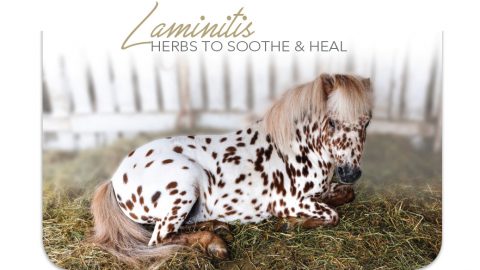Laminitis, is inflammation of the sensitive laminae, or layers of tissue, of the hoof. It may afflict either young or old horses, backyard companions or athletic competitors, and any breed. Although the causes of laminitis are varied, certain feeds, drugs, infections, hormones, concussion may trigger a systemic disturbance that affects the hoof by disrupting the normal blood flow to and from the hoof. Lack of proper blood flow causes a lack of oxygen to the laminae, which become damaged and die, leading to further tissue damage and deterioration within the hoof.
Herbs can help prevent laminitis
Because the causes of laminitis and its effects are numerous, there are many different properties and actions among herbs, and varying nutritional contents. Some herbs are largely medicinal; some are largely nutritional. Some have increased action when combined with other herbs. With herbs, because the herbs remain “whole” and complete in their composition, the properties maintain a balance and work together, addressing the horse as an individual.
For horses who are prone to laminitis, I assess the horse to see which of these herbs can be used to aid digestion, cleanse the body, improve bodily functions, and promote healthy tissue growth such as Burdock Root, Chamomile, Cleavers, Dandelion root or leaf, St Mary’s thistle seed, Comfrey, Nettle.
Dealing with laminitis
Acute cases need your veterinarian’s attention immediately, as every intervention is critical. Herbs can support your veterinarian’s approach so if your horse has a tendency to be laminitic don’t ignore early warning signs such as uncoordinated movement, anxiety, increased heart rate, immobility and a reluctance to turn. Later signs but still in the acute stage, may be a rocked-back stance, lameness, reluctance to move forward, and signs of extreme pain such as heavy breathing, flared nostrils, and patches of sweat.
Chronic cases technically begin as soon as there is rotation, or sinking, of the coffin bone. Laminitis can devastate the entire hoof, so appropriate treatment will be a group effort among the farrier, veterinarian and other specialists. Good supportive care such as proper nutrition and the implementation of natural therapies can do much to encourage new hoof growth and aid recovery.
Herbs that support treatment of laminitis
Normal blood flow through the foot may be mildly or severely altered. Herbs can assist greatly in this circumstance by promoting healthy circulation. Hawthorn berry and Bilberry assists with blood flow and pressure, especially peripheral circulation.
If your horse develops infections and abscesses in their feet, a garlic and hawthorn blend works well. Adding pain-relieving herbs such as white willow and devil’s claw is also helpful. Celery seed has anti-inflammatory action and helps improve the appetite. Chamomile is anti-inflammatory and improves circulation and digestion. Comfrey leaf helps soothe inflamed tissues and promotes fast healing.
Among the herbs beneficial for strengthening the hoof and encouraging the growth of healthy hoof and tissue are kelp, rose hips and garlic.
When dealing with a case of laminitis, always consult your veterinarian immediately. Treating at an early stage vastly improves the prognosis. Be sensible and aim for prevention of laminitis. Herbs are not necessarily the most appropriate course of action for every condition, so it is important to consult your veterinarian and qualified herbal specialist for guidance before treating with herbs.
by Catherine Bird ©2003







